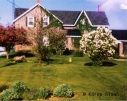
Forget-me-not flowers, from Les Fleurs Animées, by J.J. Grandville (1803-1847)
The dainty, true-blue Forget-me-not flower, or Myosotis, is a European native now naturalized throughout much of North America, including spots in my garden.
The name comes from the Ancient Greek μυοσωτίς “mouse’s ear”, which the foliage is thought to resemble.
This harbinger of spring and member of the Borage family, prefers moist habitats and spreads prolifically in partial shade along the edge of a woodland.
Once planted, they’ll likely always be there! They self-seed readily, but they’re easily removed if one feels they’re starting to take over the garden, tho’ I can’t imagine anyone feeling that way.
Medieval folklore tells us the tale of a knight errant and his lady-faire who walked along a river.
That gentleman bent down to pluck a bouquet of these flowers for his lady-love, only to lose his footing on slippery rocks. He fell into the river and the weight of his armour was too much. It pulled him underneath the watery depths.
It’s said that his last words cried out to his damsel, before being claimed by the depths was, “Forget-me-not”!
In a similar tale, a young couple, on the eve of being married, walked along the banks of the Danube. The bride-to-be saw one of these lovely flowers floating on the waves, which seemed ready to carry it away. She spoke of her admiration for the beautiful flower and her regret for its destiny.
Her husband-to-be, induced by love (and probably wanting to impress), gallantly stepped into the water to retrieve the coveted blue flower.
He grasped the flower but unfortunately he sank into the watery depths, but made one last effort to throw the flower upon the shore at the moment of disappearing for ever, where he exclaimed, “Virgils mich nicht” since which time this flower has been made emblematical, and taken the name of Forget-me-not.”
Because of this, it’s fairly obvious why one of the main meanings for the forget-me-not in Victorian floral language concerns ‘Love in absence’.
To this day, the forget-me-not is given to someone who you hope will keep you in their thoughts. A lovely little reminder for us all.
 “That name it speaks in accents dear
“That name it speaks in accents dear
Of love, and hope, and joy, and fear;
It softly tells an absent friend
That links of love should never end;
Its whispers waft a swelling breeze
O’er hill and dale, by land and seas,
– Forget-me-not”
Sources
- The Wild Flowers of Britain and Northern Europe; Fitter, Fitter, Blamey; Collins; 3rd edition 1978
- USDA, NRCS (n.d.). “Myosotis sylvatica”. The PLANTS Database (plants.usda.gov). Greensboro, North Carolina: National Plant Data Team.
- The Language of flowers. Publication date 1834, Osborn & Buckingham, New York
- Harper Douglas, “Etymology of forget-me-not,” Online Etymology Dictionary, accessed April 24, 2022,
- NBN Gateway.Myosotis sylvatica Ehrh. ex Hoffm. [Wood Forget-me-not], NBN Gateway. Retrieved 24/04/22
- The sentiment of flowers; or, Language of flora, by Tyas, Robert, 1811-1879, Publication date: 1869


 Spring is just around the corner. That happy thought leads me to my happy place; being outside in the garden.
Spring is just around the corner. That happy thought leads me to my happy place; being outside in the garden. Here in central Ontario Canada, there are still a couple of months before that can happen. After all, it’s February and the only thing growing in our yard are the piles of snow, and if I want to wander through my garden, I’ll have to shovel a path first. But that’s not an unhappy thought as it means I have plenty of time to plan this year’s plot and start germinating seeds.
Here in central Ontario Canada, there are still a couple of months before that can happen. After all, it’s February and the only thing growing in our yard are the piles of snow, and if I want to wander through my garden, I’ll have to shovel a path first. But that’s not an unhappy thought as it means I have plenty of time to plan this year’s plot and start germinating seeds.



 We don’t need big corporate seed companies taking care of us and choosing the foods and flowers that we can grow. Many of these companies sell varieties that are tasteless, but travel well. That’s not a good enough reason for me. Self reliance is very satisfying. It is our right to save seeds and make sure that there is enough variety on the planet. Bio-diversity is part of the cycle of life.
We don’t need big corporate seed companies taking care of us and choosing the foods and flowers that we can grow. Many of these companies sell varieties that are tasteless, but travel well. That’s not a good enough reason for me. Self reliance is very satisfying. It is our right to save seeds and make sure that there is enough variety on the planet. Bio-diversity is part of the cycle of life.